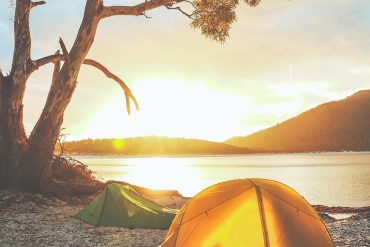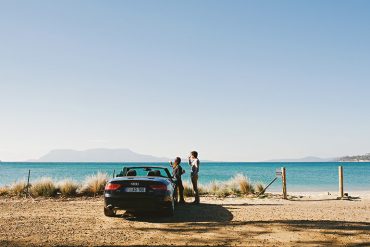Sample a cellar door
You’ll find some of the best vineyards of the Great Eastern Wine Drive between Orford and Priory. Visit cellar doors at Darlington Vineyard, Boomer Creek Vineyard, Milton Vineyard, Gala Estate, Craigie Knowe, Spring Vale Vineyard, Devil’s Corner, Freycinet Vineyard,—where you can also sample Freycinet Extra Virgin Olive Oil, made from olives grown on the adjoining grove. Further along the coast are Overtime, IronHouse and Priory Ridge. Many cellar doors offer tasting plates or meals.
Coles Bay and Freycinet National Park
The Freycinet Peninsula is one of best known and loved destinations on Tasmania’s East coast. Take the Coles Bay Road turnoff from the Tasman Highway to reach Coles Bay and the Freycinet National Park. Take some time to visit the Freycinet Marine Farm on your way and taste fresh oysters and mussels, or enjoy a long walk along the breathtaking Friendly Beaches. This is also the location for the Freycinet Walk—a luxurious four-day guided walk that has been named one of the eight Great Walks of Australia.
Coles Bay is a vibrant seaside village on the edge of Freycinet National Park. From here, you can take full advantage of countless outdoor experiences, from cruises, sea kayaking expeditions and fishing charters to guided walks, quad biking and scenic flights. Take in the postcard views of the peninsula from the Wineglass Bay Lookout or explore the walking trails and beaches of the national park. Coles Bay has beautiful beaches, including Muir’s and Richardson’s Beach, and some great places to eat, like Geographe Cafe, (which also serves fantastic espresso coffee) and the Bay Restaurant or Richardson’s Bistro at Freycinet Lodge, within Freycinet National Park.
Check our Outdoor Experiences blog for more information about activities in Freycinet National Park and the Freycinet Peninsula.
Bicheno
This part of the coast is a hub for wildlife experiences. Apart from the native wildlife you’re bound to see as you walk in the region’s national parks and cruise the coastline, there are some great wildlife experiences around Bicheno. Visit Natureworld wildlife sanctuary, five minutes’ drive north of Bicheno, to see Tasmanian devils and other native wildlife, or book your place on the nightly Bicheno Penguin Tour or Devils in the Dark experiences. And, for a glimpse of life below the surface of the sea, join a tour aboard the Glass Bottom Boat.
Bicheno has a huge range of accommodation, and great places to eat—including Blue Edge Bakery, Pasini’s Wine Bar and Deli, or the Sea Life Centre for fresh seafood. The Farm Shed Bicheno boasts the largest selection of local wines, gins and whiskeys on the coast and if you’re here in November, don’t miss the Bicheno Food and Wine Festival—an annual celebration of east coast produce, winemakers, chefs and gourmet food producers. Check our Food and Wine blog for more suggestions.
Take some time while you’re here to browse Bicheno’s galleries and shops, and spend time walking along the foreshore trails and lazing a day away on one of the uncrowded local beaches.
- Distance Swansea to Coles Bay: 58 km/36 mi. Driving time: 45 minutes.
- Distance Swansea to Bicheno: 43 km/26 mi. Driving time: 35 minutes.
PS. To help plan your visit, you can check our travel times and driving distances.


